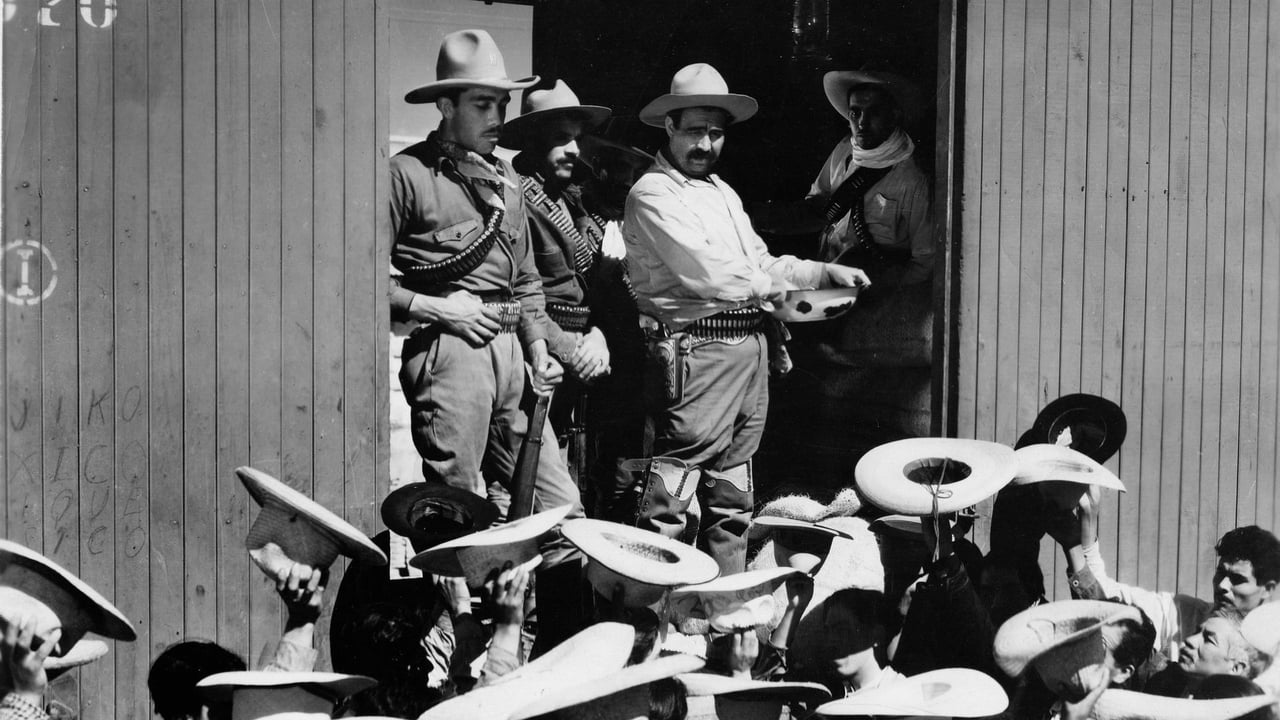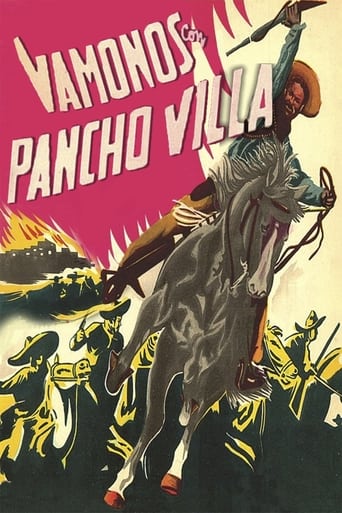

I was lucky enough to watch this film on TV and the digitally mastered and renewed version on DVD produced by the UNAM (Mexico's Autonomous National University) finishes when Tiburcio is left after he shot Becerrillo because he suffered from measles. Villa fears Tiburcio because he believes he has measles, too, and tells him to wait there, but Tiburcio walks along the railroad.Then, in the TV version I watched, after this Tiburcio returns home and goes back to his peasant life, but Villa finds him and tells him to join the army again. Tiburcio declines because he says he needs to take care of his family and that is the only thing worth in his life. Villa says nothing and enters another room where Tiburcio's wife and children are and he shoots them, believing that now Tiburcio will rejoin his ranks, but the peasant gets a gun and tries to kill Villa, but his escorts prevent that by shooting Tiburcio. After that, Villa says it is too bad that such a good warrior did not want to continue struggling and leaves that house.
... View MorePoorly directed with a weak script and lacking character development, it tells the story of 6 idealistic peasants called the Lions of San Pablo who join Pancho Villa's army. The film is cut up into episodic segments each ending in the noble death of a soldier. Themes of disillusionment and disenchantment permeate the film.War is never glamorous, often not fought honorably either: Often the most heroic die while the cowards and opportunists survive and prosper. This film depicts war in precisely that fashion.Finance Banks subsidized the making of this film and upper-class critics lauded this terrible film, not due to its artistic merits (which it lacks), but due to it's anti-revolutionary message. It depicts Villa as a monster and the revolution as evil. It is pure propaganda failing to show the suffering and starvation of the majority of the population, who were peons (debt slaves). It was their desire to end this suffering and create a better world that led to the Mexican Revolution. Pancho Villa wasn't a saint. He was a man. However, the peons and workers wouldn't have joined or supported Villa's army if he had been a monster. True the revolution came to an end, but not because Villa or Zapata were inhuman men, but because the suffering peons could not compete with American-made machine guns imported by the Obregon regime who supported big American corporations in Mexico. In fact, Villa & Zapata were so popular, they had to be assassinated: Zapata in 1919 & Villa in 1923.The revolution though was from a failure, however, as unions became legal, working conditions improved, and land was redistributed to the peasants. This film is straight revisionism (rewriting of history). In fact, its original ending had to be changed. It was so anti-revolutionary there were fears of rioting by many Villa's followers.
... View MoreMany folks consider this one of the very best Mexican films and I noticed that most of the reviews for the film loved it. The Mexican-based reviewers all gave it 10s or 9s on IMDb. The sole non-Mexican (before this review) was not in the least impressed by the film--giving it a 4! I think this is because the film has a very strong resonance for Mexicans--something that will likely be lost on other folks. Like the lone negative review, I don't have the emotional or cultural connection that made me love "Let's Go With Pancho Villa"-- and that may be why I was also so indifferent to the film. I didn't hate it but I obviously didn't see it in what the Mexican reviewers saw.The film is about a group of six men from a small Mexican town who call themselves "Los Leones de San Pablo" (The Lions of St. Paul). They join up with Pancho Villa's revolutionary army and through the course of the film, they die off one by one. That is, until the end when there are two left and one of them has smallpox--and the other is ordered to kill him and burn his body!!After doing his duty, the sole survivor simply walks off into the night--presumably to return home to his family. HOWEVER, the DVD also contains an alternate ending--one that seems tacked on to make the viewers understand that Villa, after a while, became a real scum-bag and a man whose army lost their ideas. While the nihilistic alternate ending does a good job of making you hate Villa, it also seems overlong and a bit silly.So why was I so indifferent to the film? The biggest reason were the battle scenes. Many (particularly earlier in the film) seemed almost like they were filmed in slow motion and there was no energy whatsoever about them. What SHOULD have been rousing scenes instead just seemed to drag on and on. So, technically speaking, this aspect of the film left a lot to be desired. I also thought the character 'Fatso' was a bit of a cheap stereotype. As for what I liked, when they weren't fighting, the acting was quite nice-- subdued but in a good way. Overall, a film that I was only mildly intrigued by at best and one that, to me, isn't even close to the best Mexico has to offer.
... View More1936 proved to be a defining year in Mexican director Fernando De Fuentes' career, as it was the year when he released the two most important movies of his career: the musical comedy "Allá en el Rancho Grande", and the war drama "Vámonos con Pancho Villa". Two very different movies whose results defined the future of De Fuentes' work. The last one to be shot, but the first to be released, "Allá en el Rancho Grande" became the most successful Mexican movie as the time, breaking box office records and receiving praise across the globe. On the other hand, the last par of his Revolution trilogy, "Vámonos con Pancho Villa", suffered a troubled shooting and awful reception at box office. These results would make De Fuentes to decide to focus on commercially successful movies from now on, however, time has proved that while a commercial failure, "Vámonos con Pancho Villa" was De Fuentes' true masterpiece about the Revolution.The movie is the story of Tiburcio Maya (Antonio R. Frausto), Melitón Botello (Manuel Tamés), Miguel Ángel del Toro (Ramón Vallarino), Martín Espinosa (Rafael F. Muñoz) and the Perea brothers (Raúl De Anda and Carlos López), six very good friends who one day decide to participate in the Mexican Revolution by joining the forces under the command of General Pancho Villa (Domingo Soler), considered a hero by the group. Fighting alongside their hero, the gang begins to be noticed as a very skilled and brave team (earning the nickname of "Lions of San Pablo"), but while very exited at first, as the war goes on the gang begins to discover that war is not as glorious and fair as they thought it was, that courage and honor worth nothing in the battlefield, and that even history's greatest heroes can have very inhuman traits.Based on a novel by Rafael M. Muñoz (who experienced Revolution first hand and also played a role in the film), the movie was written by Fernando De Fuentes himself with the collaboration of poet Xavier Villaurrutia. In a very straight forward fashion, the story follows the six friends and their misadventures fighting against the Federal government alongside one of the many Villa's squadrons. While De Fuentes' use of the six characters as one collective hero indeed does sacrifice some character development, he makes sure to establish a distinct personality for everyone to make up for that. Once again De Fuentes takes a critic position on the Revolution and instead of glorifying the war, he shows it as a corrupting hell where people is used like mere objects by those commanding the armies.Film critic A.O. Scott once called De Fuentes "the Mexican John Ford", and this movie is quite probably the reason behind his statement. Finally working with a good budget, De Fuentes does an amazing job in recreating life during the Revolution complete with really good choreographed battles and an extensive care for historical accuracy. Visually, the film is a joy as De Fuentes' care for realism is wonderfully captured by the cinematography of the legendary Gabriel Figueroa (in of his first jobs) which together with De Fuentes' masterful domain of the montage techniques form a powerful and crude portrait of the war. In spite of the great technical merits of the movie, De Fuentes keeps the film focused on his characters and the crumbling of their ideals, effectively portraying the human side of the conflict.In one of this earliest roles, legendary actor Domingo Soler plays the man himself, Pancho Villa, and as the general, Soler delivers a terrific performance that truly humanizes the figure of the general, avoiding myths and portraying him with all his virtues and flaws. While the "Lions of San Pablo" are our collective hero, some have more prominence than others. Antonio R. Fraustro makes an excellent job in his performance as Tiburcio Maya, the leader of the "Lions" and the one who idolizes Villa the most. Manuel Tamés is simply perfect as the funny Melitón Botello, showing not only his talent for comedy, but also a powerful dramatic presence. Ramón Vallarino plays "Becerrillo", the youngest of the gang, and while struggles a bit, doesn't do a bad job. The rest of the cast has lesser screen time, but there are good performances by Carlos López "Chaflán" and a very young Raúl De Anda.At the time of its release, "Vámonos con Pancho Villa" was completely overshadowed by De Fuentes' other movie, as the public preferred the uplifting musical comedy over the grim and dark meditation on the war. The harsh criticism De Fuentes makes about the revolutionaries and the figure of Pancho Villa (who is shown as a man far from the heroic ideal) didn't help in this matter, and the movie ended almost forgotten. However, "Vámonos con Pancho Villa" is truly a monumental epic that shows the talent of De Fuentes as a director able to portray introspective human drama in an epic adventure, pretty much on the level of John Ford and Sam Peckinpah. Of course, when compared to his previous movie, "El Compadre Mendoza", the plot may seem simplistic, but De Fuentes never lets his story get boring or tiresome.While many critics consider "El Compadre Mendoza" as De Fuentes' best movie, personally I think that "Vámonos con Pancho Villa" is the movie where his style is at its best as everything just fits nicely with his vision of the Revolution. Sadly, the poor results of the film almost ended De Fuentes' career, so he spent his following years making commercially successful movies without caring too much for the art. Still, this movie is a fitting ending for his Revolution trilogy, and a fitting closure to the first era of Mexican sound films as this film inaugurated the "Golden Age of Mexican Cinema". 10/10
... View More